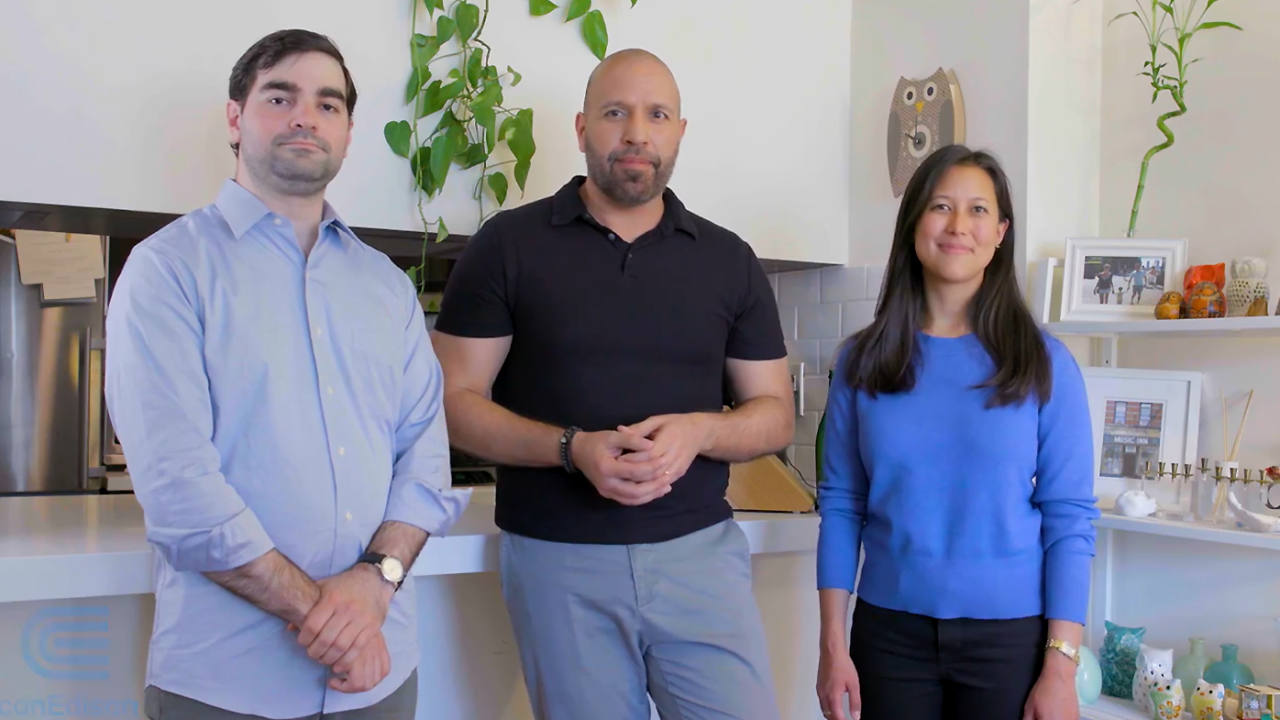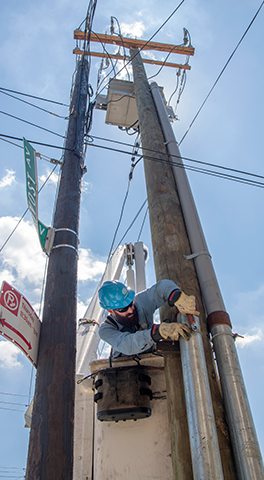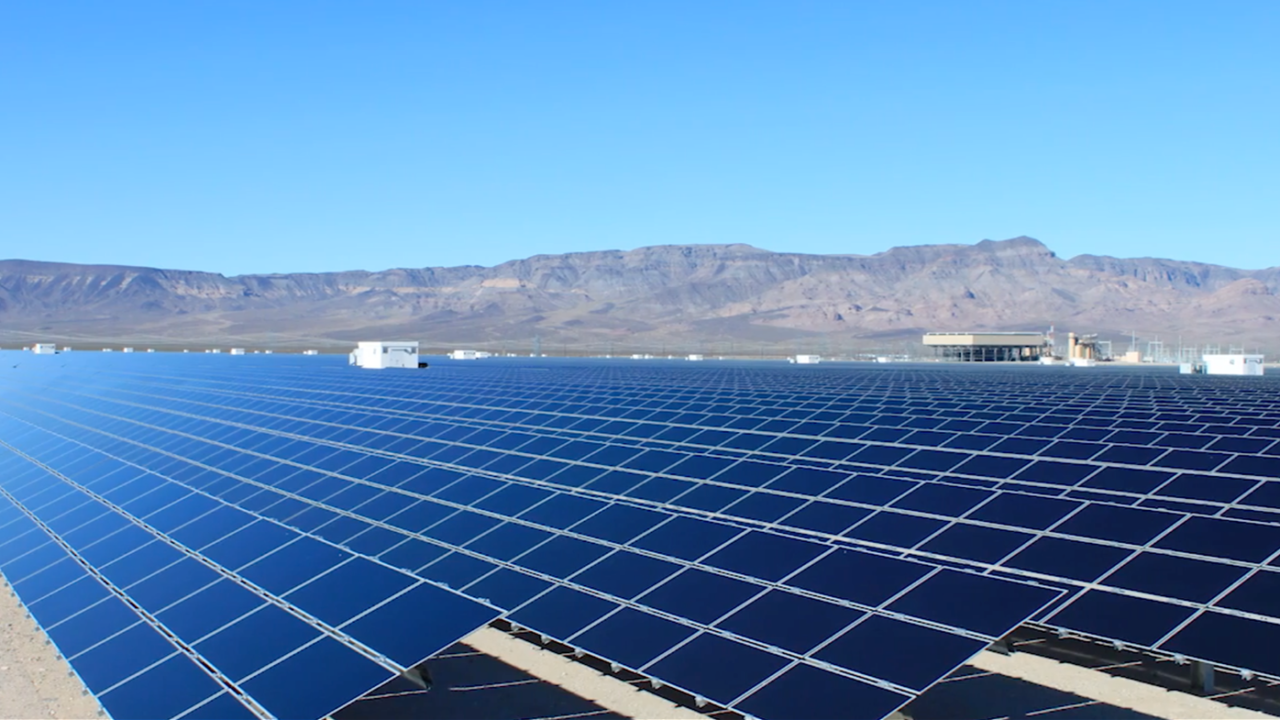
Customer & Community
Energy Efficiency, Renewables & Distributed Energy
As part of our commitment to alternative forms of energy, Con Edison Clean Energy Businesses has invested approximately $5.8 billion in renewable projects in 17 states. Con Edison Development added 1,230 megawatts of aggregate capacity (MW AC) of renewable projects to our portfolio, for a total of 2,588 MW AC at the end of 2018. Last year, the company purchased solar and wind plants from Sempra Energy worth $2.1 billion, which makes us one of the top three largest owners of solar photovoltaic assets in North America.
Renewable sources, such as solar and wind, produce energy when the sun is shining or the wind is blowing. That makes battery storage especially important to store power when it is produced and deliver it when it is needed. Storage can help ensure reliability and can reduce peak demand.
Sixteen percent of electricity used by O&R customers was generated from renewable energy resources in 2017. We continue to make our customers aware of energy efficiency improvements that will help them save money on their bills and give them more control over their energy usage. We work regularly with customers and regulators to test new models for the distribution of energy.
Energy Efficiency & Demand Response

Con Edison’s broad array of energy efficiency initiatives is designed to reduce harmful greenhouse gas emissions, lower customer bills, and give New Yorkers control over their energy choices.
Our customers are as diverse as the area we serve. That’s why we have targeted efficiency programs to help us deliver cost-effective and customer-centric energy efficiency offerings that emphasize the clear benefits and impacts of energy efficiency. We focus on four primary customer segments — commercial and industrial, small business, multifamily, and residential — designing our offerings to meet each customer group’s needs. Our goal is to give customers multiple options and opportunities to reduce their energy use.
Electric customers who chose energy-saving HVAC, lighting, building management systems, and other equipment received $65.8 million in incentives in 2018, a 19% increase from the previous year. Our gas customers received $11.1 million in incentives, a 155% increase from the previous year. Technology is giving households and businesses new ways to reduce energy use, and we’re in the forefront in helping customers get more value for their money while protecting the environment. Upgrades made by customers last year through our energy efficiency programs reduced electrical usage by 395,200 megawatt hours and saved 588,100 dekatherms of gas — that’s equivalent to taking more than 66,000 cars off the road for one year or powering 37,000 homes for one year. The proposals would put New Yorkers on a path toward a cleaner energy future, with reductions in carbon emissions and more renewable energy options that achieve goals in both the short term and potentially through 2050.
Energy Services partnered with Energy Efficiency to help streamline the distributed generation process and assist customers like never before through customer engagement, technology enhancements, and business process improvement. These improvements helped us achieve a 20 percent increase in customer satisfaction on large distributed generation projects in 2018. Also in 2018, Con Edison interconnected 53 megawatts (about 6,000 cases) worth of Distributed Energy Resources including solar, CHP, fuel cells, and battery storage. A large contributor to this was about 34 MW of residential solar installations.
O&R customers who upgraded to high efficiency energy-saving HVAC, lighting, building management systems, and other equipment received $2.7 million in incentives from us in 2018. As a result of these upgrades, more than 6,000 O&R customers reduced their bills and lowered their carbon footprint. The My ORU Store, our online customer marketplace, provided customers with a one-stop shopping experience and introduced customers to innovative smart home technologies, including smart thermostats, along with a myriad of connected-home products, like Wi-Fi security cameras, smart plugs, wireless dimmable lighting, and electric vehicle chargers. Through My ORU Store, O&R partnered with the local water utility, SUEZ NY, to support their water conservation program by offering instant rebates to mutual customers on water and energy efficient products. The program strives to help customers save water and energy and in turn lower their utility bills.
We are on the forefront of using technology to give households and businesses new ways to reduce their energy use, get more value for their money, while protecting the environment. For example, upgrades made by customers through our energy efficiency programs reduced electrical usage by 24,000 MWh and saved 9,332 dekatherms of gas. This brought our carbon reduction to more than 103,000 tons, which is equivalent to taking more than 22,000 cars off the road.
Of the total O&R rebates issued in 2018, two large projects stand out. One is the city of Middletown in Orange County. The customer upgraded lighting at all their municipal buildings, along with their LED streetlights recently purchased from O&R. The city’s upgrades amount to an estimated savings of 1,685 MWh, which is equal to approximately $225,000 per year. The other customer is a large retail company in Rockland County, who upgraded entirely to LED lighting and is estimated to save 800 MWh, equal to about $95,000 per year.
Learn more about how energy efficiency upgrades can save money and protect the environment at our website www.oru.com/save.

Reforming the Energy Vision Projects

Con Edison continues to take a leading role in making distributed energy resources (DERs) available to customers. Our Brooklyn-Queens Demand Management project aligns strongly with New York’s Reforming the Energy Vision initiative. Instead of spending $1.2 billion to build a substation to serve Brooklyn and Queens, we issued an RFI that provided alternative forms of energy. We awarded contracts and procured smart thermostats, lighting controls, batteries, and other distributed energy resources to meet the demands of customers during the peak period of 4:00 p.m. to midnight while easing the burden on our substations.
Additionally, our Customer Energy Solutions group is running new business model demonstrations in the areas of storage integration; electric vehicle (EV) infrastructure; community distributed generation; energy efficiency/DER marketplaces for residential and commercial customers; and delivering energy services to low- and middle-income (LMI) customers. For example, two front-of-the-meter storage projects, which demonstrate both grid support and energy market revenue-sharing partners, were selected through a rigorous RFI process and are in the construction stage. Three LMI demonstration projects are progressing, with two finalized by the PSC, including a community solar project. Three EV infrastructure projects that facilitate growth and reduce barriers to EV ownership are expected to be completed in 2019, including a project in White Plains where electric school buses will feed battery power back into the grid. The residential marketplace site, marketplace.coned.com, has 25 product categories that include a “pick my solar” module; we also have a new EV comparison shopping site, cars.coned.com.
Renewables
Con Edison and O&R continue to support New York State’s ambitious clean energy policies, including the state’s goal to source 50% of its energy from renewable resources by 2030. New York State has recently expressed an interest in raising the 2030 renewable energy goal to 70%.
For the past decade, Con Edison and O&R along with Sustainable CUNY (at the City University of New York), government agencies, and other parties, have encouraged residents and businesses to consider solar to reduce their energy bills and protect the environment. Our customers are responding, using the power of the sun to have generated by year-end 2018 more than 228 megawatts of clean, renewable power through 23,588 Con Edison installations, and 95 megawatts through just over 7,500 O&R installations – enough to power more than 24,000 homes.
Con Edison believes that all customers, regardless of their income level or whether they live in a house or an apartment, should have access to clean energy. In striving for this, we are working to make renewable energy available to low-income customers by installing solar panels on company roof space and grounds, then transferring the solar power to those customers via bill credits. Resources should be online in 2019. The New York Public Service Commission says this innovative solar program “is filling a niche that hasn’t been fully served in the state.”
O&R continues to work on technology advances in the interconnection process to assist customers with technical evaluations of large (greater than 50 kilowatts) and small (less than 50 kilowatts) projects. O&R is connecting community DG and battery storage projects. The company is participating in an innovative project developed at the University of Vermont that received a $1.8 million award from the U.S. Department of Energy SunShot Initiative. As part of this project, O&R will help develop the technology and strategy to improve the electric grid’s ability to accommodate power generated from renewable energy sources. The award, one of only 13 given nationally, is part of SunShot’s newest program called Enabling Extreme Real-Time Grid Integration of Solar Energy, or ENERGISE.

Energy Storage
Con Edison and O&R are supporting the state’s ambitious energy storage goals of 1,500 megawatts (MW) by 2025 and 3,000 MW by 2030 across a variety of efforts. We actively engaged with the Department of Public Service and the New York State Energy Research and Development Authority (NYSERDA) on the Energy Storage Roadmap, which culminated in December with the Public Service Commission issuing an order on storage. As part of the order, we will develop and deploy at least 310 MW of utility-scale storage connected directly to the grid. Through this project and others, we will continue to engage with the PSC, NYSERDA, and storage stakeholders to help advance the state’s energy storage vision. We actively advocate for cost-effective storage deployments that complement our existing efforts, other state clean energy goals, and benefit the grid and all customers. We are already engaged with energy storage across a variety of projects and programs by supporting state policy goals, testing new business models, building utility capabilities, engaging third party providers, and supporting customers.
We continue to support individual customer storage projects by improving the interconnection process. By the end of 2018, Con Edison had interconnected a total of 30 behind-the-meter storage systems, totaling 2,800 kW of capacity, and O&R also interconnected 30 BTM energy storage systems, totaling 233 kW of capacity.
In 2018, Con Edison commissioned its first utility-owned storage project, a lithium-iron phosphate battery installation designed for 2 MW / 12 MWh in Ozone Park, Queens. The battery was built to support load relief in the Brooklyn Queens Demand Management area. Building on this model, we requested funding for six utility-owned energy storage projects totaling 31.5 MW / 120 MWh in the recent Con Edison rate case filing. These projects will be located at and connected directly to utility substations across the service territory. Proposed sites were chosen to provide diverse geographic and use-case experience, including grid support. In the same filing, Con Edison also proposed at 10 MW / 40 MWh turnkey energy storage docking facility. This project will allow third-party developers to install storage at the facility to directly access the grid and associated market revenues. Additionally, electric vehicle (EV) DC fast chargers will be co-located on the site, allowing us to gain a better understanding of how energy storage can help facilitate the adoption of EV charging on the grid.
Con Edison continues to implement energy storage demonstration projects to test new storage business models. Con Edison is advancing its Storage on Demand demonstration, a 1.5MW / 4 MWh mobile storage model that will deploy via three separate 500kW / 1.34 MWh mobile storage trailers to areas of grid need – in locations that may have otherwise been served by utility diesel generators. The 4 MW / 4 MWh customer-sited front-of-the-meter business model demonstration, Beyond BTM, will be deployed across four customer sites to provide grid support by summer 2019. Each project will provide distribution load and voltage relief and reduce network peak demand while testing the ability to garner revenues for participating in New York Independent System Operator markets. Through its Innovative Storage Business Model demonstration project, O&R is working with partners to develop innovative business models for driving down the cost of energy storage investments by enabling storage assets to participate in multiple markets, providing benefits and incentives to multiple stakeholders.
Con Edison and O&R also support energy storage through non-wires solutions (sometimes referred to as non-wires alternatives) program procurements. Both companies consider and often include storage as part of the program’s load relief solution portfolios. Con Edison has incentivized 300 kW / 1.2 MWh of storage at the Marcus Garvey apartment complex in Brooklyn as part of its Brooklyn Queens Demand Management Program (BQDM) and is expecting an additional 4MW / 16MWh system at another BQDM location by summer 2019. Con Edison is currently engaged in storage procurement discussions for its Water/Plymouth Streets project, and we’re evaluating additional storage projects as part of our other active solicitations for non-wires solutions.
O&R has two open procurements for energy storage systems to meet distribution system needs in place of traditional wires solutions. O&R’s Monsey project will aim to defer the upgrade of an existing substation. Due to extensive load growth in the Monsey area, the current substation does not have adequate capacity to serve the forecasted load. The Monsey non-wires alternative will aim to deploy a portfolio of 15MW / 58MWh batteries at three separate locations in the Monsey area to defer the upgrade of this substation. O&R’s Pomona energy storage system will be utility owned and installed on property jointly owned by Con Edison and O&R. The project will aim to deploy a 3MW / 12MWh battery to defer the construction of a new transmission/distribution substation. O&R is soliciting vendors for two additional non-wires alternatives RFPs (Blooming Grove and West Haverstraw). These two projects may also include battery storage projects in their technology portfolio.
Con Edison continues to take the lead in addressing battery safety concerns, working closely with the city’s Department of Buildings, the Fire Department of New York (FDNY), battery technology developers, and NYSERDA. Con Edison and NYSERDA previously partnered on an effort to better characterize battery hazards, along with testing suppression agent performance through burn tests by an independent lab. Con Edison has also conducted tests jointly with FDNY at their training facility. Con Edison continues to work with these stakeholders to advance understanding of battery operations, safety requirements, and emergency response procedures.
Energy storage is a transformational technology that can provide numerous benefits to the electric system, and ultimately, to electric customers. Con Edison and O&R envision a future where storage provides support to the distribution system, enables the operation of intermittent renewable resources, and reduces GHG emissions and other local emissions. Declining costs and broader proliferation of storage will help customers and communities adopt these technologies. Storage will allow for customers to manage their usage, participate in energy programs, and respond to more cost-reflective rate designs, such as hourly pricing and demand-based rate structures. Storage supports the integration of new applications, like EV charging.
